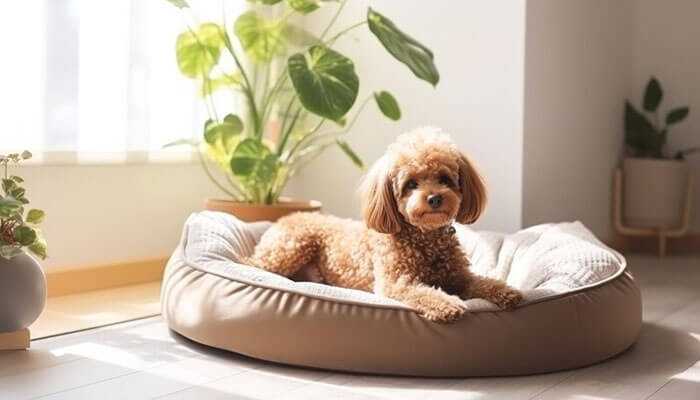Your dog’s comfort is a top priority, especially when it comes to providing them with a safe space to relax, retreat, and settle. For many pet owners, this sanctuary takes the form of a crate – a cozy doggy den of sorts equipped with a Crate Pad for your dog.
However, if you’ve got a chew-happy pup, your standard-issue crate setup might not stay comfortable for long. In this guide, we’ll look into the ins and outs of selecting a crate pad that’s both chew-resistant and canine-comfy.
Durability Matters
When it comes to withstanding the tenacity of a determined chewer, not all materials are created equal. Thus, identifying chew-resistant materials will be the first step toward pad longevity.
The resistance of materials to the sharp teeth of your dog depends on the weave and density. In general, high-denier nylon and reinforced canvas are excellent choices. These fabrics are tough and can be made even more chew-proof with special treatments.
Evaluating Thickness and Density
A pad that is too thin or too squishy can mimic the texture of plush toys, tempting your dog to tear it apart. Look for materials with a substantial thickness that still provide comfort and support.
Stress-Testing Crate Pads
Before purchasing a pad, it’s worth simulating potential chewing behavior. While in the store, give the pad a good press, feel for any weak points, and imagine your dog doing the same.
Comfort Considerations
Even the most resilient pad must keep your furry friend comfortable. After all, a chew proof crate pad should be a place your dog actively wants to be.
- Balancing Chew-Resistance and Softness: Finding the sweet spot between durability and softness is crucial. Certipur US Certified Foam with a robust outer layer can offer comfort while withstanding chewing.
- Orthopedic Support for Aging Pups: For older dogs or those with joint issues, orthopedic support can make all the difference. Look for a pad that won’t compress over time, even with constant use.
- Breathability and Temperature Regulation: Dogs’ bodies are less efficient at temperature regulation than humans’. A breathable pad can prevent overheating, particularly if your dog tends to be active in the crate.
Easy Maintenance
Crate pads can get dirty quickly, so ease of cleaning is non-negotiable for many pet owners.
- Removable and Washable Covers: Pads with removable, machine-washable covers are a game-changer. Ensure that you can easily take the pad apart for thorough cleaning.
- Waterproof and Stain-Resistant Surfaces: Accidents happen. A waterproof pad can save your carpet and make clean-up a breeze.
- Quick-Drying Capabilities: You don’t want to deal with a pad that takes days to dry. Choose a design that dries quickly to avoid any unpleasant odors or discomfort for your pup.
Size and Fit
A pad that’s either too big or too small can quickly become a point of interest for a chewing dog, so it’s crucial to find the right size. Before making a purchase, it’s important to measure the inside dimensions of your dog’s crate to ensure accuracy and find the perfect fit.
When selecting a pad, aim for one that leaves a small margin around the edges of the crate, providing a snug but not tight fit. Additionally, an unsecured pad can easily become a chew toy, so look for options that offer a way to anchor it to the crate, whether it be through straps or non-slip backing, to prevent any unwanted chewing behavior.
Puppy-Safe Crate Pads
Puppies are notorious chewers, but a proper introduction to a crate pad can establish it as a non-toy.
Introducing the Crate Pad Gradually
Instead of suddenly placing a new pad in your puppy’s crate, which might overwhelm or confuse them, take a more gradual approach. Start by allowing them to sniff and explore the pad outside of the crate, slowly moving it inside over time. This helps acclimate them to its presence in a more natural and less stressful way.
Discouraging Chewing Behavior
Puppies naturally explore the world with their mouths, but it’s important to supervise your puppy closely and intervene if they start to chew on the crate pad. A “no” can be effective in interrupting this behavior. Immediately offer them an appropriate chew toy instead. This not only stops the unwanted behavior but also redirects their chewing instinct to something more suitable.
Reinforcing Good Habits
Positive reinforcement is a powerful tool in shaping your puppy’s behavior. Whenever your puppy shows disinterest in chewing the pad or chooses to chew on their toy instead, make sure to praise them enthusiastically.
This reinforces the good behavior, making it more likely they’ll repeat it. Consistent positive reinforcement helps your puppy understand what behaviors you’re looking for, encouraging a harmonious living situation for both of you.
Sustainable Solutions
Investing in a sustainable crate pad not only benefits the environment but can also stand up to the rigors of dog ownership.
Eco-Friendly Materials
When shopping for pads, it’s wise to seek out those made from organic or recycled materials. Opting for these environmentally friendly choices not only significantly reduces your ecological footprint but also provides you with products that are often sturdier and more durable than those made from conventional materials.
Long-Lasting Durability
Invest in durability for the long haul. Choosing a pad that’s designed for longevity not only saves you money over time by reducing the need for frequent replacements but also contributes positively to the environment by minimizing waste sent to landfills.
Responsible Disposal Options
When the time comes to part with your crate pad, opt for recycling or donate it to a shelter. Responsible disposal closes the loop on a sustainable product’s lifecycle.
Customizable Comfort
Why not add a bit of flair to your dog’s crate with a pad that reflects their unique personality? Many sellers provide options to personalize pads with your dog’s name, their favorite colors, or even designs specific to their breed. When choosing a pad, it’s also important to consider how it will integrate with existing crate accessories, such as bumpers, covers, or mats.
Additionally, the needs of different breeds should be taken into account. Larger breeds might need pads with a more substantial build to support their size, while smaller dogs could prefer something softer and cozier. Tailoring your choice to fit your dog’s size and needs can make their crate a more comfortable and inviting space.
Conclusion
In closing, finding the perfect crate pad for your dog involves a delicate balance of durability, comfort, and practicality. Take the time to assess your pet’s needs, habits, and the environment in which the pad will be placed.
By investing in a chew-proof crate pad, you’ll not only protect your dog’s comfort but also make sure that their special place remains a sanctuary for years to come. After all, a dog’s crate is more than just a steel enclosure with a cushion.




